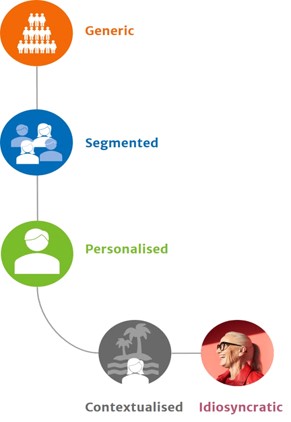LONDON, UK, 23 October 2020 8am, the leading telecoms analyst firm Omnisperience has announced new research that predicts a step change in the evolution of personalisation.
PERSONALISATION NOT DEAD, JUST EVOLVING
In December 2020 Gartner made a controversial prediction: by 2025 80% of marketers who had invested in personalisation would have abandoned their efforts. They said this was because personalisation will fail to show adequate ROI and because of the perils of data collection, integration and protection.
But is this the end of personalisation?
Omnisperience doesn’t think so. Partly because personalisation is as old as the hills and pre-dates the current technology-based enthusiasm for it by centuries. Small retailers have always built their businesses on personalised service and customised products. In contrast, big companies favoured standardisation to achieve economies of scale and operational efficiency. But these self-same large enterprises are now seeking to utilise the secret sauce of small firms to differentiate their own offerings.
“Personalisation isn’t new,” says Teresa Cottam, Chief Analyst at Omnisperience. “What’s new is using technology to automate and industrialise personalisation to create intimacy and engagement at scale.”
Cottam argues that while personalisation isn’t dead, our understanding and utilisation of it is rapidly changing. Companies rushed to adopt Personalisation 1.0, she says, as a quick fix, a panacea to solve all customer ills. Personalisation 2.0 is far more nuanced and accepts that while it is a powerful tool, personalisation has to be used in conjunction with other strategies not for short-term ROI but to build and deepen longer-term relationships with customers. Extra dimensions are also being added, as personalisation becomes more sophisticated and evolves beyond microsegmentation into realtime, contextualised and idiosyncratic experiences.
Cottam adds that personalisation only works when it is applied more broadly across the entire customer experience from marketing to sales, products, pricing, bundling, offers, service, care, communications and so on. But she notes that it’s essential that personalisation is adaptable. Companies will need to gauge where and how far to personalise, and they need to interact and engage with customers to do this.
Omnisperience views personalisation not as something that’s imposed upon customers, but something that comes out of an interaction between customers and the company. Here ‘selfie’ technologies, such as self-configuration and self-personalisation, have a critical role to play by putting the customer in control and helping to avoid many of the pitfalls of ‘bad’ personalisation such as overly familiarity, presumption and intrusiveness.
Part of the problem here is that ‘personalisation’ is an inexact term that is applied to a wide range of different scenarios. Understanding the different flavours of personalisation is vital. As is appreciating that personalisation exists on a spectrum and that customers’ tolerance for it, as well as its effectiveness, depends upon the pre-existing relationship companies have with their customers.
To help companies understand more the evolution of personalisation, Omnisperience has released a complimentary Discussion Paper.
****ENDS****
INFORMATION FOR EDITORS
Omnisperience is a leading independent analyst and advisory firm, focused on B2B Telecoms Service Providers, their vendors and business customers. Omnisperience’s purpose is to help B2B service providers become more profitable by understanding and meeting the evolving needs of their customers. For more information see omnisperience.com
Supporting materials:
Additional quotes:
“Personalisation is the icing on the cake; it isn’t the cake itself because in this metaphor the cake is the relationship.” Teresa Cottam, Chief Analyst, Omnisperience.
“Personalisation isn’t something you do TO customers; it’s something you do WITH customers. With their co-operation and their permission.” Teresa Cottam, Chief Analyst, Omnisperience.







